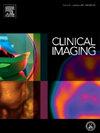Evaluating provider knowledge and practices in breast cancer screening: Identifying gaps and barriers to informed referrals
IF 1.5
4区 医学
Q3 RADIOLOGY, NUCLEAR MEDICINE & MEDICAL IMAGING
引用次数: 0
Abstract
Purpose
To evaluate knowledge and practices of primary care providers on high-risk breast cancer screening imaging recommendations.
Methods
A 10-question anonymous survey was distributed via e-mail to primary care providers. The survey assessed provider knowledge of screening guidelines, current referral practices, perceived barriers to timely screening implementation, and preferences in screening methodologies. Responses were aggregated and results reported descriptively.
Results
Response rate was 23.3 % (49/210). Majority 55 % (27/49) were obstetricians or gynecologists, 35 % (17/49) were internal medicine or primary care physicians, and 10 % (5/49) were advanced practice providers from the obstetrics and gynecology and internal medicine departments. Nearly all the respondents reported that they routinely assess patients for breast cancer risk. However, more than a quarter (28 %, 14/49) of respondents disagreed that all women should have their lifetime risk of breast cancer assessed by age 25–30, with those remote from their training more likely to disagree (p < 0.001). There was variability in knowledge of appropriate breast imaging screening exam for those identified as high-risk for developing breast cancer, with MRI (69 %, 34/49), mammography (65 %, 32/49), ultrasound (59 %, 29/49), and genetic testing (55 %, 27/49) all being recommended in close proportions. Multiple barriers to routine cancer risk assessment were identified, with time constraints (20 %, 8/40), cost (18 %, 7/40) and lack of knowledge (18 %, 7/40) of assessment tools most frequently reported.
Conclusion
High-risk breast cancer screening recommendations practice patterns vary among different specialty primary care providers. Lack of time and knowledge were the main barriers for breast cancer risk assessment evaluation. Future interventions should focus on provider education to optimize imaging recommendations.
评估提供者在乳腺癌筛查方面的知识和实践:确定知情转诊的差距和障碍
目的评价初级保健提供者对高危乳腺癌筛查影像学建议的知识和实践。方法通过电子邮件向初级保健提供者发送一份包含10个问题的匿名调查。该调查评估了提供者对筛查指南的了解、目前的转诊做法、及时筛查实施的感知障碍以及筛查方法的偏好。对反馈进行汇总,并对结果进行描述性报告。结果有效率为23.3%(49/210)。55%(27/49)为妇产科医生,35%(17/49)为内科或初级保健医生,10%(5/49)为来自妇产科和内科的高级执业医师。几乎所有的受访者都表示,他们会定期评估患者患乳腺癌的风险。然而,超过四分之一(28%,14/49)的受访者不同意所有女性都应该在25-30岁时接受乳腺癌终生风险评估,那些远离培训的人更有可能不同意(p <;0.001)。对于那些被确定为乳腺癌高危人群的适当乳腺影像学筛查检查的知识存在差异,MRI(69%, 34/49)、乳房x光检查(65%,32/49)、超声检查(59%,29/49)和基因检测(55%,27/49)的推荐比例相近。确定了常规癌症风险评估的多种障碍,最常报告的是时间限制(20%,8/40)、成本限制(18%,7/40)和缺乏评估工具知识(18%,7/40)。结论不同专科初级保健提供者的高危乳腺癌筛查建议和实践模式存在差异。缺乏时间和知识是乳腺癌风险评估的主要障碍。未来的干预措施应侧重于提供者教育,以优化影像学建议。
本文章由计算机程序翻译,如有差异,请以英文原文为准。
求助全文
约1分钟内获得全文
求助全文
来源期刊

Clinical Imaging
医学-核医学
CiteScore
4.60
自引率
0.00%
发文量
265
审稿时长
35 days
期刊介绍:
The mission of Clinical Imaging is to publish, in a timely manner, the very best radiology research from the United States and around the world with special attention to the impact of medical imaging on patient care. The journal''s publications cover all imaging modalities, radiology issues related to patients, policy and practice improvements, and clinically-oriented imaging physics and informatics. The journal is a valuable resource for practicing radiologists, radiologists-in-training and other clinicians with an interest in imaging. Papers are carefully peer-reviewed and selected by our experienced subject editors who are leading experts spanning the range of imaging sub-specialties, which include:
-Body Imaging-
Breast Imaging-
Cardiothoracic Imaging-
Imaging Physics and Informatics-
Molecular Imaging and Nuclear Medicine-
Musculoskeletal and Emergency Imaging-
Neuroradiology-
Practice, Policy & Education-
Pediatric Imaging-
Vascular and Interventional Radiology
 求助内容:
求助内容: 应助结果提醒方式:
应助结果提醒方式:


